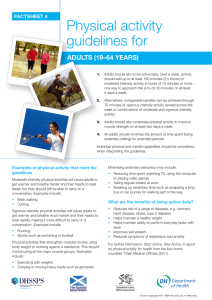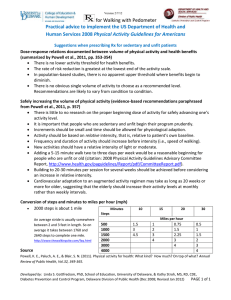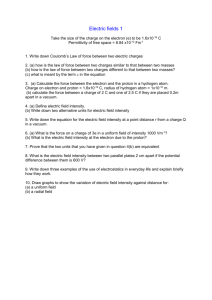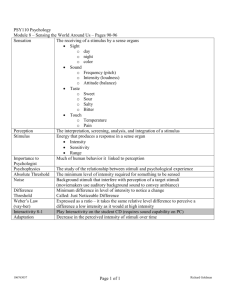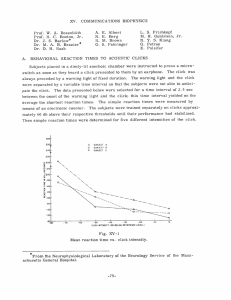WHY MEASURE PHYSICAL ACTIVITY?
advertisement
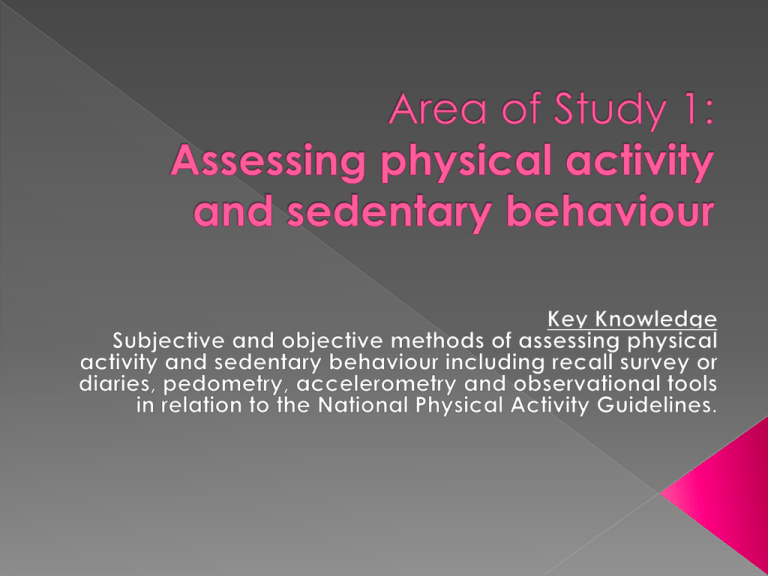
Class brainstorm activity! WHY MEASURE PHYSICAL ACTIVITY? Identify concerns relating to health & fitness e.g. rise in sedentary behaviour & obesity Identify at risk groups and trends e.g. older adults, women, indigenous, low socioeconomic, non-English speaking, obese people Monitor levels of physical activity to see whether they are active and compare against the use of screen based entertainment. Plan appropriate physical activity interventions Evaluate interventions Population Level Individual Level - To document the frequency and distribution of physical activity in defined population groups - To monitor the achievement of physical activity guidelines and population trends over time. - To study the relationship between physical activity and health conditions (e.g. cardiovascular risk factors, type 2 diabetes, obesity, and mental health) - To determine the amount or dose of physical activity required to influence specific health parameters. - To identify the biological, psychological and environmental factors that influence physical activity - To evaluate the effectiveness of largescale physical activity intervention programs - To detect change in an individual’s health and or behaviour - To determine the effect of any change in physical activity behaviour Active Australia survey results worksheet The NPAG are divided into 5 categories: - Children (0-5years) - Children (5-12years) - Youth (12-18years) - Adults - Older Australians (65+) Each of you will be given a table to fill in relating to the National Physical Activity Guidelines. You will fill the table in using the information for each sub group which will be distributed around the room. If you would like a copy of the printed information it was taken from the following website: - http://www.health.gov.au/internet/main/publishing.nsf/content/healthpubhlth-strateg-phys-act-guidelines#rec_0_5 Workplace or occupational – football player, builder, walk the stairs instead of the elevator. Household and gardening chores – vacuuming, sweeping etc Leisure-time activity – organised (netball) & non organised sports (walking) Active transport – walking, cycling instead of driving for transport Read Textbook: Nelson Physical Education VCE Units 3 & 4 (5th Edition) Malpeli, Telford, Whittle, Corrie (p.8-12) Type – type of activity Intensity - exercise intensity Frequency – how often? Duration – for how long? Classification of Physical activity intensity Metabolic Equivalent (MET): concept expressing energy cost •A MET rating of 1.0 occurs at rest = reference point •A MET value of 6.0 indicated an intensity 6 times that of rest Intensity Classification Description Low intensity This is the lightest category in terms of perceived and actual exertion expenditure. Moderate intensity Generally consists of sustained rhythmic movements. At this level you should feel some exertion but still be able to carry out a conversation comfortably. Vigorous intensity Participation at these levels leads to a substantial increase in heart and respiratory rates. METs <3 7 Energy expended (kj/min) % max HR Examples of activities <15 <50 Walking slowly, golf, gardening, household chores 15 - 30 50 - 70 Bike-riding (moderate pace) playing tennis doubles, dancing, weight lifting 30 70 Skipping, running, boxing, playing squash Sedentary Behaviours: are associated with low levels of energy expenditure (1-2 METS) and linked to various negative health consequences involve sitting staying in the same place for long periods of time (watching TV, commuting by car, reading, using a computer, etc....) can be seen in people who are highly active - but not at the same time only apply to people up to 18 years of age in the National Physical Activity Guidelines (as of 2010) but likely to include adults in the future
